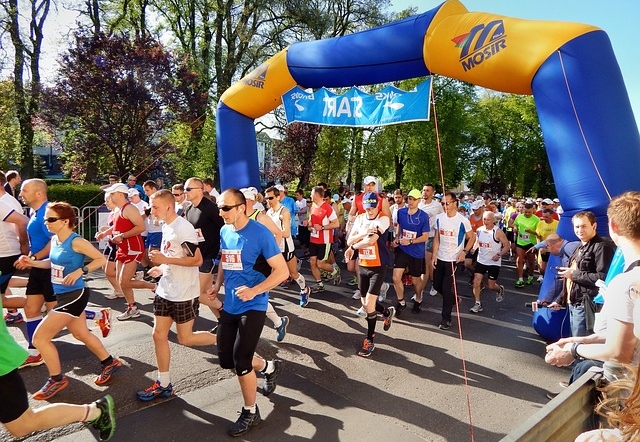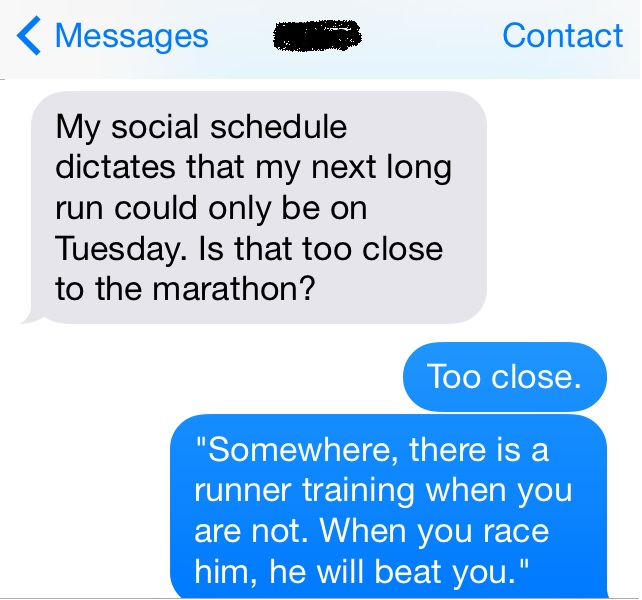As a coach, I’m most nervous during the return to running after a marathon phase of training. Aerobic fitness remains high but the body is still reeling from the aftermath of racing 26.2 miles.

The injury risk is significantly higher post-marathon, when the heart and lungs are in great shape but your “structural fitness” is weak.
If you’re coming off a big marathon PR, you may feel like running fast just a week or two after the race, but that may cause a running injury and even compromise your long-term development as a runner.
In fact, the bodily damage you experience after a marathon is significant. Even if you “feel good” 3-5 days after a marathon, muscular damage takes up to two weeks to fully heal. But that’s not all:
- Muscular strength is limited, with inflammation and cell damage persisting for up to two weeks after the marathon
- Immune function is severely compromised and it’s far easier to get sick, making it more important to focus on nutritious food, hydration, and great sleep
- The heart may even experience damage in runners who are not as prepared to race 26.2 miles (don’t worry, it heals just fine)
- Muscle memory is compromised, making fast running more difficult in the 2-3 weeks after the marathon (and riskier for injuries)
So… scared of the marathon distance yet?!
Don’t be. The marathon is a safe event. But the significant trauma incurred from racing 26.2 miles as hard as possible requires significant recovery efforts, which is why I prefer a structured recovery plan.
When I work with my runners after a marathon, their recovery plans resemble a “reverse taper” (except without the fast workouts). The goal is to maximize recovery while limiting the chance of a running injury.
This approach is also similar to many off-season training plans. For folks who crave structure, having a plan that shows exactly what to do after a race (including ice baths, strength exercises, cross-training, running, and mobility exercises) can be enormously helpful.
When many runners wonder if they’re doing too much or not enough, a structured program after a marathon can help you successfully return to running after a marathon without the injuries.
Consider a custom training plan after your race to help plan your reverse taper, maximize marathon recovery, and reduce your injury risk.
Return to Running After a Marathon: The First 1-5 Days
As soon as you cross the finish line, the top goal is facilitating the recovery process (after fist pumping because of your enormous personal best, of course).
For the specifics on what can help you recover faster, see my previous article The Definitive Guide to Marathon Recovery.
Today I want to focus on the actual training – how to return to running after a marathon.
During the first 3 days after the race, you shouldn’t run or do any other formal exercise with one exception: the day after the race it’s recommended to do a very easy 15-30 minutes of light exercise.
My favorite types of cross-training for post-marathon are pool running, swimming (both for the hydrostatic recovery benefits of water and the complete lack of impact force), cycling, elliptical, and walking in that order. These forms of exercise prioritize the healing power of water with no impact forces. If you don’t have access to a gym, pool, or bike you can go for a short, easy walk.
To provide a different perspective, I reached out to Tom Goom, a physiotherapist with over 10 years of clinical experience. In addition to being quite a good runner himself, Tom has shared his expertise abroad (Sri Lanka) and written for Men’s Running UK, Running Fitness, and the British Journal of Sports Medicine blog.
He’s also the creator of Running Physio, where he helps runners train smarter and get stronger.
Regarding post-marathon running, Tom says:
I don’t recommend a specific number of days off post-marathon as it depends a great deal on each athlete and how they feel. Some even find a recovery run a day or so after the marathon seems to help recovery. Usually though, after 1-2 days I suggest trying to stay active to avoid stiffening up but keeping it gentle. A swim, short walk or cycle ride can help a lot, just don’t over do it.
I suggest to go by feel and return with a short, slow run when you feel ready. Delayed Onset Muscle Soreness (DOMS) usually peaks by day 2 or 3 so it may be best to run after that has settled. You usually feel a lot better within a week but full recovery from a marathon make take a month or more.
You can see that we’re mostly in agreement here, though some runners do enjoy a very short run the day or two after a marathon. I tend to be overly cautious about recovery, so I prefer zero-impact cross-training.
But notice that full recovery from a marathon can take up to a month – or more. That means you can’t race or run difficult workouts for at least a month after a marathon!
If you suffered a running injury during the race, now is the time to either see a specialist or proactively treat it yourself if you understand your injury. For more on injury prevention, see this free email series.
6-10 Days Post-Marathon
About a week after the marathon is when to resume exercise. During a “reverse taper,” I have my runners begin with easy aerobic cross-training (like pool running or cycling like I mentioned before) or a combination of light strength and flexibility exercises – or a combination depending on the runner.
After 2-4 days of cross-training, the first run can be attempted. I call this a “diagnostic run” as the sole purpose is to evaluate how your body responds to running.
How do you feel? Does anything hurt? What muscles are particularly sore or tight?
The first run back will usually feel, well, pretty bad! Most runners report feeling “clunky,” stiff, lethargic, or uncoordinated. This is normal and reflects fatigue. Don’t freak out! Remember: you’re still in great shape, but you just need a lot of recovery to express that fitness level.
Tom adds:
The marathon is such a significant challenge for the body that it takes time to recover usual muscle function. Studies have shown reduced muscle strength, especially in the first 5-7 days post marathon, and muscle fiber repair continues for 3-4 weeks post marathon.
The solution is to allow enough time and don’t rush back too soon. Even an extra couple of days can help. Those first few runs back should be at a low intensity, with a focus on comfort rather than worrying too much about distance or speed.
Remember that the goal for the first several weeks of running post-marathon should be to establish consistent running again, not building fitness. Don’t focus on distance or speed – just regain a consistent rhythm of running.
11+ Days After the Marathon
This is when you can generally start training again, except with lower mileage, shorter workouts, and slower goal paces. Again, the goal is to develop consistency and build back slowly (not to prioritize some arbitrary pace or workout intensity).
Workouts should be aerobic (like tempo, steady-state, or even short 10k-paced repetitions) and all other runs should be at an easy pace. What exactly is “easy?” Remember the 3 C’s of easy running: comfortable, controlled, and conversational.
3-4 weeks after the marathon is when your workouts can start becoming more challenging, but they’re still not nearly as challenging as they were during your peak marathon training.
Always defer to what your body is telling you – it knows best! And remember: when in doubt, sit it out.
My cautious approach prefers that you not run any truly difficult workouts or challenging long runs until at least six weeks after the marathon. But as long as you’re consistently building your mileage and the overall difficulty of your workouts, you won’t lose fitness. No need to fret!
Marathon Recovery Starts During Training!
How you feel after a marathon is often a product of your preparation. Just the other day I was being interviewed by a Washingtonian journalist about marathon recovery.
And while ice baths, rest, sleep, and massage can all speed the recovery process, it’s important to remember that if you’re appropriately trained, recovery won’t take as long.
When your body is READY to race 26.2 miles, you’ll perform better and recover faster. Just make sure training is a priority, unlike this friend of mine:

All kidding aside, don’t rush your marathon preparation. Make sure you’re ready (here’s how) before you ever toe the starting line.
If you need help with your marathon recovery, check out our free injury prevention series where we share:
- The biggest wastes of your time that you should avoid (not every strategy works!)
- Case studies of other runners who’ve broken their own injury cycle
- Example strength workouts that are like physical therapy for your running muscles
- Bonus content never shared here on the blog
Check it out here and we’ll send you the first free lesson today.
Good luck with your marathon training and recovery!